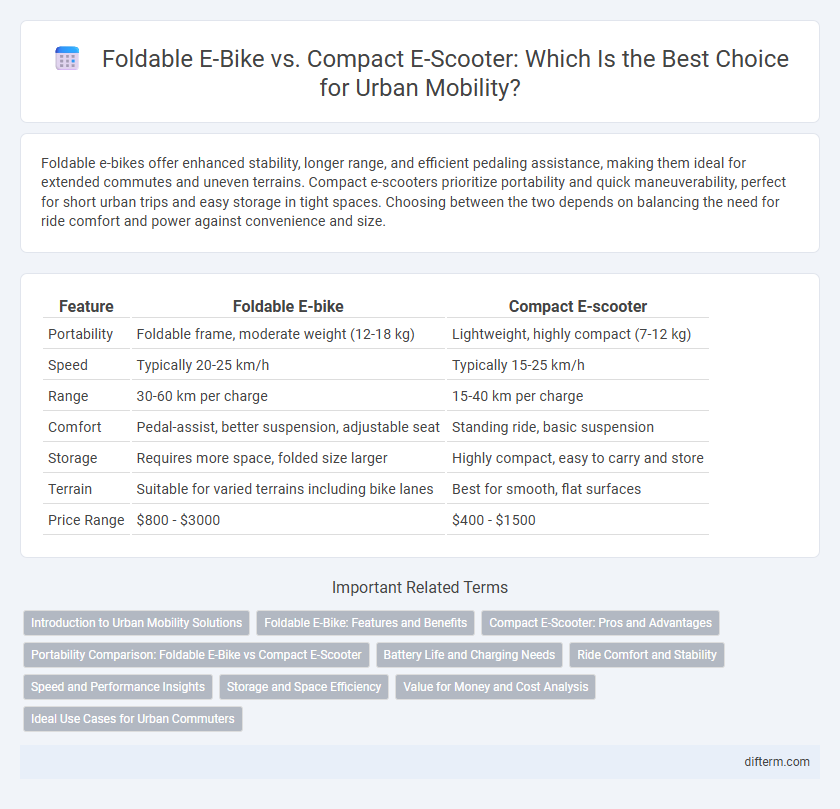Foldable e-bikes offer enhanced stability, longer range, and efficient pedaling assistance, making them ideal for extended commutes and uneven terrains. Compact e-scooters prioritize portability and quick maneuverability, perfect for short urban trips and easy storage in tight spaces. Choosing between the two depends on balancing the need for ride comfort and power against convenience and size.
Table of Comparison
| Feature | Foldable E-bike | Compact E-scooter |
|---|---|---|
| Portability | Foldable frame, moderate weight (12-18 kg) | Lightweight, highly compact (7-12 kg) |
| Speed | Typically 20-25 km/h | Typically 15-25 km/h |
| Range | 30-60 km per charge | 15-40 km per charge |
| Comfort | Pedal-assist, better suspension, adjustable seat | Standing ride, basic suspension |
| Storage | Requires more space, folded size larger | Highly compact, easy to carry and store |
| Terrain | Suitable for varied terrains including bike lanes | Best for smooth, flat surfaces |
| Price Range | $800 - $3000 | $400 - $1500 |
Introduction to Urban Mobility Solutions
Foldable e-bikes offer an extended range and enhanced comfort for urban commuting, making them ideal for longer distances and mixed-mode travel. Compact e-scooters provide superior portability and quick maneuverability, perfect for short trips and crowded city streets. Both solutions address urban mobility challenges by reducing traffic congestion and promoting eco-friendly transportation alternatives.
Foldable E-Bike: Features and Benefits
Foldable e-bikes offer a powerful pedal-assist system combined with a compact, space-saving design ideal for urban commuters. Their robust battery capacity ensures longer travel ranges compared to compact e-scooters, making them suitable for extended trips and varying terrains. Enhanced suspension and larger wheels provide improved stability and comfort, setting foldable e-bikes apart in versatility and usability.
Compact E-Scooter: Pros and Advantages
Compact e-scooters offer exceptional portability and lightweight design, making them ideal for urban commuters navigating crowded streets and public transport. Their foldable frames and smaller dimensions allow for easy storage in tight spaces, enhancing convenience over bulkier foldable e-bikes. With lower maintenance requirements and typically lower price points, compact e-scooters provide an efficient, cost-effective solution for short-distance travel and last-mile connectivity.
Portability Comparison: Foldable E-Bike vs Compact E-Scooter
Foldable e-bikes offer enhanced portability with larger wheels that balance ride comfort and stowability, folding down to dimensions typically around 30x30x15 inches for easy transport in car trunks or public transit. Compact e-scooters generally fold into smaller, lighter packages, often under 30 pounds and measuring approximately 40x16x12 inches, making them highly convenient for quick folding and carrying in urban settings. While e-scooters excel in lightweight portability, foldable e-bikes provide a superior blend of portability and ride stability, suitable for longer commutes and varied terrains.
Battery Life and Charging Needs
Foldable e-bikes typically offer longer battery life, ranging from 40 to 70 miles per charge, due to larger battery capacities compared to compact e-scooters, which usually provide 15 to 30 miles per charge. Charging times for foldable e-bikes vary between 4 to 6 hours, while compact e-scooters often require 3 to 5 hours to reach full charge. Battery management systems in both devices optimize performance, but e-bikes are better suited for longer commutes without frequent charging breaks.
Ride Comfort and Stability
Foldable e-bikes offer superior ride comfort and stability due to larger wheels and a more robust frame, providing better shock absorption and smoother handling on uneven surfaces. Compact e-scooters feature smaller wheels and a lighter frame, which can lead to less stable rides and reduced comfort over long distances or rough terrain. Riders prioritizing comfort and stability often prefer foldable e-bikes for urban commuting and varied road conditions.
Speed and Performance Insights
Foldable e-bikes typically offer higher speeds, reaching up to 25-28 mph, compared to compact e-scooters which generally max out around 15-20 mph, providing superior performance for longer commutes and varied terrains. The pedal-assist feature on foldable e-bikes enhances endurance and battery efficiency, making them ideal for distance travel, while compact e-scooters prioritize portability with quicker acceleration but limited range. Battery capacity and motor power in foldable e-bikes range from 250W to 500W, often exceeding the 200W-350W motors found in most compact e-scooters, directly impacting overall performance and speed consistency.
Storage and Space Efficiency
Foldable e-bikes offer superior storage flexibility with their ability to collapse into a compact form, making them ideal for small apartments or crowded urban spaces. Compact e-scooters prioritize minimal footprint and lightweight design, enabling effortless portability and quick stowage under desks or in lockers. Both provide space-efficient mobility options, but foldable e-bikes typically require slightly more storage space due to their larger frame and wheel size.
Value for Money and Cost Analysis
Foldable e-bikes generally offer higher value for money due to their longer range and superior versatility for commuting, despite higher upfront costs compared to compact e-scooters. Compact e-scooters excel in portability and lower maintenance expenses, making them cost-effective for short urban trips but less efficient for extended travel. Evaluating total cost of ownership, including battery life, durability, and convenience, is crucial when choosing between foldable e-bikes and compact e-scooters for urban mobility.
Ideal Use Cases for Urban Commuters
Foldable e-bikes provide greater range and faster speeds, making them ideal for longer urban commutes and mixed-mode travel involving public transit. Compact e-scooters excel in short-distance trips and quick maneuvering through congested city streets, offering superior portability and ease of storage in tight spaces. Urban commuters seeking versatility often prefer foldable e-bikes for multi-terrain routes, while those prioritizing lightweight convenience favor compact e-scooters for last-mile connectivity.
Foldable e-bike vs compact e-scooter Infographic

 difterm.com
difterm.com